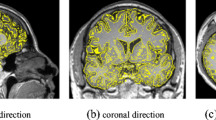Abstract
Hearing impairment has become the most widespread sensory disorder in the world, obstructing human-to-human communication and comprehension. The EEG-based brain-computer interface (BCI) technology may be an important solution to rehabilitating their hearing capacity for people who are unable to sustain verbal contact and behavioral response by sound stimulation. Auditory evoked potentials (AEPs) are a kind of EEG signal produced by an acoustic stimulus from the brain scalp. This study aims to develop an intelligent hearing level assessment technique using AEP signals to address these concerns. First, we convert the raw AEP signals into the time–frequency image using the continuous wavelet transform (CWT). Then, the Support vector machine (SVM) approach is used for classifying the time–frequency images. This study uses the reputed publicly available dataset to check the validation of the proposed approach. This approach achieves a maximum of 95.21% classification accuracy, which clearly indicates that the approach provides a very encouraging performance for detecting the AEPs responses in determining human auditory level.
Access this chapter
Tax calculation will be finalised at checkout
Purchases are for personal use only
Similar content being viewed by others
References
Deafness and hearing loss. https://www.who.int/news-room/fact-sheets/detail/deafness-and-hearing-loss. Accessed 18 June 2020
Aarabi A, Fazel-Rezai R, Aghakhani Y (2009) A fuzzy rule-based system for epileptic seizure detection in intracranial EEG. Clin Neurophysiol 120:1648–1657
Gao S, Wang Y, Gao X (2014) Visual and auditory brain – computer interfaces. IEEE Trans Biomed Eng 61:1436–1447
Sriraam N (2012) EEG based automated detection of auditory loss: a pilot study. Expert Syst Appl 39:723–731
Tan L, Chen Y, Maloney TC, Caré MM, Holland SK, Lu LJ (2013) Combined analysis of sMRI and fMRI imaging data provides accurate disease markers for hearing impairment. NeuroImage Clin 3:416–428
Li PZ, Huang L, Wang CD, Li C, Lai JH (2019) Brain network analysis for auditory disease: a twofold study. Neurocomputing 347:230–239
Mahmud MS, Yeasin M, Shen D, Arnott SR, Alain C, Bidelman GM (2019) What brain connectivity patterns from EEG tell us about hearing loss: a graph theoretic approach. In: ICECE 2018 - 10th international conference on electrical and computer engineering, pp 205–208. Institute of Electrical and Electronics Engineers Inc.
Ibrahim IA, Ting HN, Moghavvemi M (2019) Formulation of a novel classification indices for classification of human hearing abilities according to cortical auditory event potential signals. Arab J Sci Eng 44:7133–7147
Dietl H, Weiss S (2004) Detection of cochlear hearing loss applying wavelet packets and support vector machines. In: Conference record - Asilomar conference on signals, systems and computers, pp 1575–1579
Tang C, Lee E (2019) Hearing loss identification via wavelet entropy and combination of Tabu search and particle swarm optimization. In: International conference on digital signal processing, DSP. Institute of Electrical and Electronics Engineers Inc.
Sanjay HS, Hiremath BV, Prithvi BS, Dinesh PA (2020) Machine learning based assessment of auditory threshold perception in human beings. SN Appl Sci 2:1–10
Xue P, Bai J, Wang Q, Zhang X, Feng P (2018) Analysis and classification of the nasal finals in hearing-impaired patients using tongue movement features. Speech Commun 104:57–65
Zhang R, McAllister G, Scotney B, McClean S, Houston G (2006) Combining wavelet analysis and Bayesian networks for the classification of auditory brainstem response. IEEE Trans Inf Technol Biomed 10:458–467
Das N, Francart T, Bertrand A (2020) Auditory Attention Detection Dataset KULeuven
Yan R, Gao RX, Chen X (2014) Wavelets for fault diagnosis of rotary machines: a review with applications. Signal Process 96:1–15
Huang L, Wang J (2018) Forecasting energy fluctuation model by wavelet decomposition and stochastic recurrent wavelet neural network. Neurocomputing 309:70–82
Rashid M et al (2020) Analysis of EEG features for brain computer interface application. Lecture Notes in Electrical Engineering, vol 632, pp 529–540
Hortal E, Iáñez E, Úbeda A, Planelles D, Costa Á, Azorín JM (2014) Selection of the best mental tasks for a SVM-based BCI system. In: Conference proceedings - IEEE international conference on systems, man, and cybernetics, January 2014, pp 1483–1488
Zhu W, Zeng N, Wang N (2010) Sensitivity, specificity, accuracy, associated confidence interval and ROC analysis with practical SAS® implementations. Northeast SAS Users Gr. 2010 Health Care Life Science, pp 1–9
Hallac RR, Lee J, Pressler M, Seaward JR, Kane AA (2019) Identifying ear abnormality from 2D photographs using convolutional neural networks. Sci Rep 9:1–6
Mahmud MS, Yeasin M, Shen D, Arnott SR, Alain C, Bidelman GM (2019) What brain connectivity patterns from EEG tell us about hearing loss: a graph theoretic approach. In: ICECE 2018 - 10th international conference on electrical and computer engineering, pp 205–208
Mosqueda Cárdenas E, de la Rosa Gutiérrez JP, Aguilar Lobo LM, Ochoa Ruiz G (2019) Automatic detection and classification of hearing loss conditions using an artificial neural network approach. Lecture notes in computer science (including subseries lecture notes in artificial intelligence and lecture notes in bioinformatics), pp 227–237. Springer, Heidelberg
Acknowledgements
The authors would like to thank the Ministry of Higher Education for providing financial support under Fundamental research grant No. FRGS/1/2018/TK04/UMP/02/3 (University reference RDU190109) and Universiti Malaysia Pahang for laboratory facilities as well as additional financial support under Internal Research grant PGRS2003156.
Author information
Authors and Affiliations
Editor information
Editors and Affiliations
Rights and permissions
Copyright information
© 2022 The Author(s), under exclusive license to Springer Nature Singapore Pte Ltd.
About this paper
Cite this paper
Islam, M.N., Sulaiman, N., Mustafa, M. (2022). Diagnosis of Hearing Impairment Based on Wavelet Transformation and Machine Learning Approach. In: Md. Zain, Z., Sulaiman, M.H., Mohamed, A.I., Bakar, M.S., Ramli, M.S. (eds) Proceedings of the 6th International Conference on Electrical, Control and Computer Engineering. Lecture Notes in Electrical Engineering, vol 842. Springer, Singapore. https://doi.org/10.1007/978-981-16-8690-0_62
Download citation
DOI: https://doi.org/10.1007/978-981-16-8690-0_62
Published:
Publisher Name: Springer, Singapore
Print ISBN: 978-981-16-8689-4
Online ISBN: 978-981-16-8690-0
eBook Packages: Intelligent Technologies and RoboticsIntelligent Technologies and Robotics (R0)




